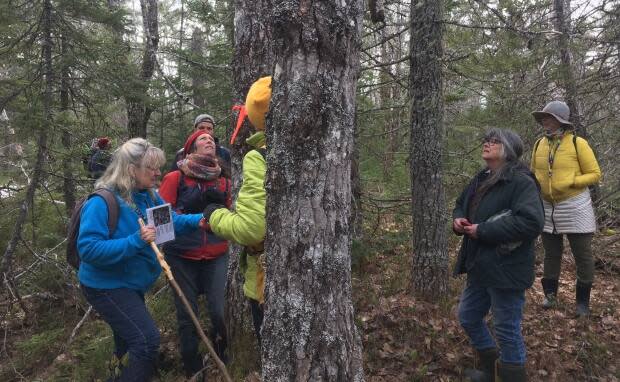Citizen scientists comb Annapolis Valley woods for rare lichens

Lisa Proulx remembers fondly time spent as a child at her parents' camp in what is now known as the Tobeatic Wilderness Area.
It's those memories, and the recognition of how things have changed through the years in the woods, that prompted her recently to take part in a citizens-led effort to look for rare lichens in the forests of Nova Scotia's Annapolis Valley.
Proulx and a group of about five others spent a recent weekend in the woods in the Beals Brook area, a site that is set to be logged.
Environmentalists have said officials with the Natural Resources Department did not do a thorough enough check for species at risk prior to approving the cut and have subsequently found examples of rare lichens, around which a 100-metre buffer must be placed.
Proulx said it takes time to learn how to tell the difference between some lichen that are common and others that are rare, but she was eventually able to do so and spotted several rare examples.
"I had to look a long time before I found one of the rare ones, I can tell you that," she said.
Looking for ways to protect the woods
Still, her enthusiasm for the work is something Nina Newington said is growing among people who have come out for these citizen-led efforts.
Newington is one of the organizers of the recent surveys, which included guidance from experts.
Like Proulx, Newington said anyone can learn to spot rare species if they're willing to be patient. As part of the so-called bio blitz, lichen identification cards were made for the three species they were most likely to find.
"Like recognizing a familiar face, once you've learned the sort of overall feel of it, it's perfectly possible for somebody who didn't know much about lichens, like me, to find and identify them," said Newington.

She and others are motivated to do the work because they see it as a way to provide added protection for parts of the woods they believe need a break from logging or should not be subject to cutting in the first place.
"People are coming because they're trying to find ways to learn about and protect the areas that are the most ecologically valuable before they're gone, before it's too late," she said.
"These lichens are rare because they depend on intact inner forests."
The provincial government continues to roll out steps to shift toward ecological forestry, four years after a report calling for dramatic change to the way the woods are managed. Natural Resources Minister Tory Rushton has said a "fundamental shift" will be in place by June.
Newington and others would like to see that fundamental shift include more landscape-level planning, something she believes is more likely to happen if people who already have an interest in being in the woods know what to look for when they're out for a walk.
MORE TOP STORIES

 Yahoo Movies
Yahoo Movies 
